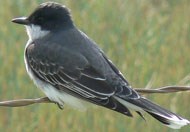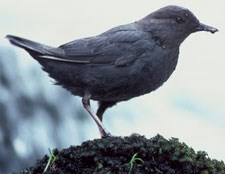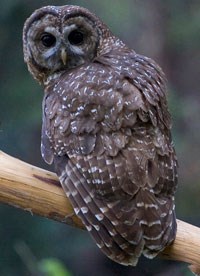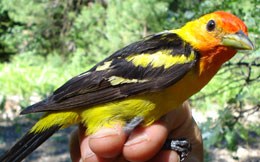

D.G./U.S. Forest Service Yosemite provides birds with 750,000 acres of unusually diverse habitats. An astounding 262 species of birds have been documented in Yosemite, including 165 resident and migratory species. Of note, 46 species have been recorded at least four times, and another 53 species have been recorded fewer than four times. Yosemite's newest birds on record: White-face ibis in April 2011 in Yosemite Valley, and the Scott's oriole in May 2011 in Poopenaunt Valley. (Hear the nasal "jeenk jeenk" of a Scott's oriole.) The key to the park's exceptional bird diversity is its extreme elevation gradient and corresponding habitat diversity from 2,000 feet to more than 13,000 feet. Accordingly, climate varies dramatically from the mild winters and hot dry summers in the foothills up to harsh long winters and short summers in alpine areas. Because birds are inextricably tied to the passage of seasons, species occupying different elevations follow radically different annual schedules. 
Dave Menke/U.S. Fish and Wildlife Bird enthusiasts visiting Yosemite National Park will see and experience different bird behaviors depending on the time of year and habitat. During the winter, it is a treat to watch John Muir’s favorite bird, the American dipper, as it plunges underneath ice in its search for aquatic insects and minnows; or a flock of gregarious mountain chickadees and red-breasted nuthatches as they mob a tiny northern pygmy-owl. During spring and fall, large numbers of migrating birds can be seen and heard as they flock through the vegetation, busily foraging on insects, seeds, berries, or other birds to build their fat supplies to supply themselves with fuel for their long journeys. Spring in Yosemite is especially exciting, when neotropical migrant flocks of warblers, vireos, flycatchers, and tanagers with brightly colored feathers and melodic songs grace the landscape. 
Jon Felis Birds are said to be excellent indicators of an area’s environmental health; therefore, many research studies and monitoring efforts seek to gain a greater understanding of bird populations, especially those in decline, and how their habitat requirements might reflect overall ecosystem health. A parkwide census of willow flycatchers, for example, has revealed that willow flycatchers no longer breed in the park, and are likely extirpated. While direct habitat associations with willow flycatchers can not be teased apart anymore, park biologists are trying to learn more about ecological integrity of wet meadows, and how various aspects of meadows, such as hydrology, affect wildlife. Yosemite's precipitous cliffs provide important habitat for peregrine falcons, which have increased in numbers through the park's management efforts. Finally, California spotted owl research suggests that the owls benefit from fires, both medium- to low-severity, that result in a forest with a relatively closed canopy and large live trees. Consistent wildland and prescribed fire programs in Yosemite are applied responsibly to ensure fire remains an important part of the forest ecosystem and protect the forests from large, high-severity fires. Not surprisingly, one of the main prey items of Yosemite’s spotted owl population, the northern flying squirrel, also benefits from these same forest characteristics. 
Jeff Moker Birding in YosemiteGood odds exist that you'll spot birds if you come prepared. Bring a bird guide, notebook, and pair of binoculars. Take the time to observe even the most common birds, such as Steller's jay, American robin, or dark-eyed junco, and note the subtle nuances in a bird's flight pattern or vocalization. Listen for the bird's song or call--long trills or short chips--made to attract a mate, declare a territory, identify family members, or announce the presence of a predator. The complexity of songs is something ornithologists are yet to unravel because it appears that different species learn to vocalize in surprisingly different ways. Some know songs at birth; some require tutoring; and some improvise to build their repertoire. And, the more time you spend observing, the greater chance you have of seeing more rare birds, like the pine grosbeak, sooty grouse, or black-backed woodpecker. In Yosemite, there are many opportunities to go birding. Join a Yosemite Conservancy birdwatching outing, led by an expert birder, who usually includes visits to some of the park's best birding hotspots. Or, check the Yosemite Guide for program offerings. Each year we have an annual Christmas Bird Count as another option to go birding in the park. If you join a group of bird enthusiasts for the first time, plan to take your time because birders are not a fast-moving group. A group of birders can spend hours in a small section of a meadow identifying birds. In the summer, patience can pay off when a songbird carrying food to a nest leaves you spellbound by the sight of tiny little babies with gaping wide-open mouths accepting a food-delivery. Most songbirds need two weeks to incubate their young and another two weeks before the young are ready to leave the nest.
Visit our keyboard shortcuts docs for details
The peregrine falcon thrives in Yosemite Valley, but this remarkable bird was temporarily extirpated from much of its native range, including Yosemite where it disappeared for decades, leading to its listing as an endangered species in the early 1970s. Because of the remarkable, collaborative efforts of Yosemite climbers, UCSC Predatory Bird Research Group, and NPS biologists, with generous funding from the Yosemite Conservancy, the story of Yosemite’s peregrine falcon is one of hope.
Visit our keyboard shortcuts docs for details
Throughout the park, unique soundscapes can be found within the beautiful landscapes. Open your eyes and ears to the birdsongs of Yosemite. |
Last updated: November 17, 2025
